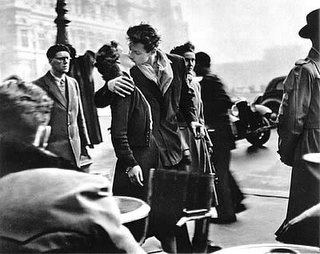 “Scan courtesy of Masters of Photography”
“Scan courtesy of Masters of Photography”Saturday morning I usually sit with friends in The Byronian cafe in Byron Bay. A weekly ritual! Usually we're quite laid back, unless something catches our eyes.
This morning for example, there was the Good Weekend section from the Sydney Morning Herald flying around with the cover photo of “The Kiss”. I recognised it instantly, in the sixties and seventies it hung in every European poster shop, in students' flats and bed rooms. However, I couldn’t remember the photographer.
Discussing the image with friends, I elaborated on how spot-on the shot reflected Paris in 1950. The people, still under war shock, yet daring to step out and there in the centre this spontaneous impulse, this intensity bringing Paris back to life.
But then, reading the SMH article I learned that the photographer was Robert Doisneau and as that the kiss was fake, staged.
According to BBC News "the woman featured in Robert Doisneau’s classic photograph of a couple kissing outside Paris city hall has sold her original print at auction.” and “Francoise Bornet and her then boyfriend agreed to pose for the seemingly spontaneous photo in 1950. The photo went on to become a poster icon around the world…..Romantics like to believe the young lovers were captured in a spontaneous moment of bliss, but the pose was staged.”
I was such a romantic.
But then, thinking about it, does that reduce its cultural or aesthetic value? What is the labouriously crafted moment of intense experience cast in an artistic medium such as a photograph that seems so light, so casual, so coincidental? We call it art. It makes our world stand still for one moment capturing our imagination, passion, or sorrow, even capturing the spirit of an entire generation. There are not many images that do this.
What else became apparent curiously enough was that my Australian friends did not know the poster. It was European thing. Later at home I found apart from BBC article a rich repository on information about Doisneau. The most interesting one Masters of Photography even give kind permission to use the images for non-commercial purposes.
The relevance and usefulness of this kind of “open source style” policy became apparent, combining sharing and fair use with some commercial solution for interested parties.
Then our discussions turned towards, images and metaphors and that’s when we touched on George Lakoff’s “Philosophy in the Flesh” … But that’s another story.
No comments:
Post a Comment